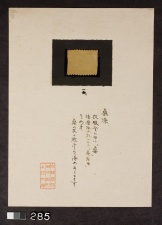Difference between revisions of "Kuwa (Mulberry tree) - center (285 C)"
Jump to navigation
Jump to search
(username removed) |
m (MDerrick moved page Kuwa - center (285 C) to Kuwa (Mulberry tree) - center (285 C) without leaving a redirect) |
||
| (One intermediate revision by one other user not shown) | |||
| Line 5: | Line 5: | ||
| 285 | | 285 | ||
|- | |- | ||
| − | ! scope="row"| | + | ! scope="row"|Uemura number / title |
| − | | | + | | ; "Haze-some 25" |
|- | |- | ||
! scope="row"|Folder location | ! scope="row"|Folder location | ||
| Line 44: | Line 44: | ||
| ash water (separate bath) | | ash water (separate bath) | ||
|- | |- | ||
| − | ! scope="row"| | + | ! scope="row"|Uemura's notes |
| − | | The fabric was soaked into 1) dye bath; and 2) ash water bath. This dyeing technique should be "Kuwa ( | + | | The fabric was soaked into 1) dye bath; and 2) ash water bath. This dyeing technique should be "Kuwa ()" in the Ebukuryo (), from the 8th century. AD, Japan; and "Kuwa-bara no sato ()" in the Harima fdo-ki (), 8th century. AD, Japan. |
|- | |- | ||
| − | ! scope="row"| | + | ! scope="row"|Uemura's date |
| Kyoto Murasakino | | Kyoto Murasakino | ||
|} | |} | ||
| − | [[Category: | + | [[Category:Uemura dye archive]] |
Latest revision as of 14:25, 23 June 2020
| Museum number | 285 |
|---|---|
| Uemura number / title | ; "Haze-some 25" |
| Folder location | 4th shelf |
| Sample location | center (285 C) |
| Fiber type | silk |
| Color | pale yellowish brown |
| Dyestuff (Japanese common name) | 桑 : Kuwa |
| Dye (English common name) | Mulberry tree |
| Dyestuff (botanical name) | Morus australis Poir. (M. bombycis Koidz.) |
| Plant part | bark /dried (?) |
| Dyestuff extraction | boiled in water |
| Auxiliary agent in dye bath | - |
| Mordant | - |
| Other auxiliary agent | ash water (separate bath) |
| Uemura's notes | The fabric was soaked into 1) dye bath; and 2) ash water bath. This dyeing technique should be "Kuwa ()" in the Ebukuryo (), from the 8th century. AD, Japan; and "Kuwa-bara no sato ()" in the Harima fdo-ki (), 8th century. AD, Japan. |
| Uemura's date | Kyoto Murasakino |
